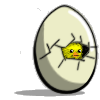|
Is it common for holdfasts to not hold very well initially? I cut my 1st 3/4" hole into the top with my auger last night to test one out just before bed. I hammered it in pretty good but it didn't hold down a piece of 3/4 inch board worth a drat. Googled around a bit and found that sanding / filing the stem of the holdfast could help. I just spent a little time running a strip of 100 grit around the stem and it seems to have improved somewhat, but it's still a bit slippery. Before I go and take a coarse file to it I figured I'd ask here in case there was another problem I might be missing. The laminated benchtop is about 3" thick at the point of this hole. I hand augered it with a brace and I might have not been perfectly steady. The hole doesn't seem to be sloppy or oblong though, so I am hoping that's not it but figured I'd ask before I go and drill a bunch of possibly useless holes into the top.  In better news I got the planing stop hole mortised in and it's quite snug and sturdy. Might switch over to a laminated bit of red oak instead so it looks nicer on the bench than the current stop I have. Parts for a screw vise of some kind are arriving by Monday. Still deciding if I should use a leg vise or a large horizontal face vise off the side of the apron. Honestly it seems like the leg vise may be a bit more sturdy, but I kinda think they are ugly and I like the idea of having a much larger horizontal surface area to grab with for a face vise setup. But, I don't know poo poo about poo poo here so if this still sounds like a bad idea please feel free to weigh in.
|
|
|
|
|

|
| # ? Apr 29, 2024 19:06 |
|
I've already weighed in with my preference for leg vises. I also think they look better, so  As for holdfasts, it's not uncommon to need to rough up the shaft of the holdfast, but the ones you got are probably going to lead to disappointment. These are really good.
|
|
|
GEMorris posted:I've already weighed in with my preference for leg vises. I also think they look better, so Thanks. Yeah I am like 60/40 on the vise choices and its mostly just on looks. For some reason I just don't like the look of the leg vise all that much. With the wood / equipment I have on hand I can build it either way once the parts show up so will continue to think it over.
|
|
|
|
|
I bought a pair of smithed holdfasts on Etsy of all places and they've been perfect.
|
|
|
|
Iirc the holdfast effectiveness is also related to the angle it can makein the hole
|
|
|
GEMorris posted:I've already weighed in with my preference for leg vises. I also think they look better, so I snagged a pair of those and they showed up this morning, did not expect that fast of a turnaround. Yes, they are really much better. Thanks for the recommendation. I am finishing up the bench and while waiting on the vise parts to arrive have started building a wall mounted tool shelf / hanging rack type thing and have a bunch of fairly poorly dimensioned red oak 1x8" stock to work with. It's got a pretty gnarly cap across the middle of the board (like 1/4" or so above what would be a flat face). For cleaning up rough stock I'd been kinda loosely following a video from Chris Schwartz that was pretty detailed. https://www.youtube.com/watch?v=2_96gNMMc_g One thing he does though is use a cambered jack (scrub?) plane to go across the board. I only have a Stanley 4 and 5 and a really large antique wood joiner plane with a massive iron on it. None of them have a cambered blade. Without this type of plane should I still try to even out the face with say the #5 as is? Or, is there a better way to do it apart from just buying a dedicated scrub plane? Just wondering if the benefit is worth investing in another tool again so quickly or not. I tried to just knock down the middle with the joiner plane by successive passes with the grain down the middle of the board. That worked more or less but it took loving forever for just a single 1x8"x22" board and I've got to do like 5 of those so just wondering if I need to suck it up and accept the time spent or not.
|
|
|
|
|
You don't need a scrub plane. You just need to put a heavy camber on your #5 plane's blade. Schwarz has a blog entry somewhere describing how he does this but is is very beneficial to have a grinder. You need the camber so you can traverse across the grain with the blade set aggressively, that's how stock gets removed quickly.
|
|
|
|
That Works posted:I snagged a pair of those and they showed up this morning, did not expect that fast of a turnaround. Yes, they are really much better. Thanks for the recommendation. You could just buy another blade for one of those planes and put a camber on it. That way you can just swap it out when you need to prep stock. I have 2 blades I use with my jack plane for this exact purpose.
|
|
|
|
Spring Heeled Jack posted:You could just buy another blade for one of those planes and put a camber on it. That way you can just swap it out when you need to prep stock. I have 2 blades I use with my jack plane for this exact purpose. Yeah, the #5 and the #4 use the same blade size, so if he found himself in a situation where he felt like he needed a straight or nearly straight blade in the 5 he could just borrow the blade from his smoother. Just to reiterate my previous post. The cambered blade is the special part, and Schwarz is right when he says pretty much any jack/fore plane will do, it doesn't have to be fancy. It's a revaletory experience using a jack plane with a cambered blade for the first time. GEMorris fucked around with this message at 14:18 on Apr 8, 2018 |
|
|
|
Awesome, good to know! Was not sure if I needed to widen the throat as well, possibly necessitating a while other plane.
|
|
|
|
|
That Works posted:Awesome, good to know! Was not sure if I needed to widen the throat as well, possibly necessitating a while other plane. You can get away with setting the chip breaker further back. Iíve never actually used a dedicated scrub plane before, itís on my list of tools to pick up eventually.
|
|
|
|
Since we are kinda on the subject already, Any recommendations on chip breaker and camber settings for a giant old joinery plane? Here's the setup I have:  When I bought it the blade was ground with no camber and I just honed it flat and straight as is. It works, but I've not been able to find a good middle ground when using it. It either just baaaarely takes out a few thin un even shavings, or it's gouging out stuff way too thick and leading to tearout / really binds up on any small knots in the wood. The blade itself is sharp, but I am wondering if I have the chip breaker set too close for this type of plane. A lot of it is due to me still learning how to adjust these kinda planes with a hammer etc I am sure, but was curious about the iron and chip breaker config as well.
|
|
|
|
|
I think you're fine there. I haven't found the chip breaker setting to matter all that much, I usually do a little less than an 1/8th on my jack and a little closer on the try and smoothing planes. If the shavings aren't jamming in the mouth or behind the chip breaker, you're probably fine. Except for rounding the corners a little bit, I don't put a camber in my try plane. The try plane is meant to flatten the faces and edges, so you want a flat blade that won't leave scallops. You probably know the basics: try turning the board around to get a different grain direction; plane out the high spots, not the low spots; run the corner of some scrap across the blade to be sure it's parallel. I haven't used wooden planes myself, so there may be plane setup issues that I can't diagnose. My best guess is you're just not getting the blade projection right. E: Also if you're dealing with knots, sometimes you just have to give up and leave that spot a little high. It's likely in the middle of the board, so it won't affect your joinery. You can then hit the surrounding area with a card scraper to clean up the grain at finishing time. ColdPie fucked around with this message at 14:53 on Apr 8, 2018 |
|
|
|
That Works posted:
So this is your try/jointer plane. The Schwarz recommendation is to set this blade with a light camber (so the corners don't dig in, and so that you can use the camber to help square board edges - that's for a separate post though). This type of camber you can establish with a coarse sharpening stone, you don't need a bench grinder like you do for establishing a heavy camber on a jack/fore plane. On a try plane the chipbreaker should be set "medium" which for me usually means around 1/24" and 1/16" ish. As for troubles, knots are just trouble for most any plane. You can try planning from a different direction as suggested, or try skewing the plane (presenting the plane to the work at an angle) where the plane is still traveling across the board paralell to 45 degrees, but the plane body is rotated so that the direction of planning is not paralell to the plane body. As for setting the blade to the right depth, I can't help you as I use metal bodied planes with depth adjusters. GEMorris fucked around with this message at 15:51 on Apr 8, 2018 |
|
|
|
Thanks all, super helpful. Decided to go ahead and put in a leg vise instead of face, so gonna start working on that today. 
|
|
|
|
|
Gonna go take a look at this today, 50Ä. I am not sure what my plan is here.... Just wanna take a look at it, see if I can use this. My own DIY build keeps on stalling. Stuff I want / need to change and setbacks resulting in loss of motivation. Currently it's far too heavy for me to get up on top of the cyclone unit which is ready and in place. And I need to design some kind of mount for it anyway to get it to seat i the same place over the cyclone consistently, and be airtight. Maybe this thing is possible for me to hook up to my cyclone, or use parts of it for it, or maybe I can use it as is in my shop as it is until I get my own setup in place. Must be better than my shop vac. Now that I have a metal lathe I am considering stuff like making my own flange for the homemade impeller to get a better / stronger mounting solution. Ideally I would like to find a smaller, 2.2kW 2900rpm motor, I think the weight reduction would be worth the tradeoff, this 4kW motor is a beaaast. I could make the impeller smaller too.  This dude has a lot of things out for sale now, a bandsaw for 200, table saw for 450. They're all cast iron machines. Seems like the bandsaw went already, it was a loving steal. Looked a lot like my own saw except blue, maybe a little smaller. http://www.findit.fi/sv/1280511.htm (link is in swedish) Also those M42 blades are worth their price, ran through a nail when re-sawing this weekend, blade didn't care. And at 1/4" it does stuff I usually used to put on the 5/8s blade for.
|
|
|
|
I'm afraid that machine was far too puny. Pictures make it seem bigger than it is, and a tiny aluminum impeller that looked like the surface of the moon. Not such a good deal as I thought.
|
|
|
|
I've been on working on a new box but I'm not sure how to handle certain parts of it. Here's a mock-up of what the finished box could look like: The thing I'm not sure about is how to handle the surface. I want a glossy, clear surface like in this video, at around 6 minutes in, although it doesn't need to be as ridiculously reflective as it is in that video: https://www.youtube.com/watch?v=K0pXjV4zGDM I've only been working with stains so far, and I've always put polyurethane or lacquer on top of the stain to achieve a glossy look. However, this time, I want to use dark grey or black paint and contrast it with the white paint patterns. I assume I'll have to use acrylic paint to stencil in the floral pattern, so I assume I can't exactly do the same thing that the guy in the video did, which is apparently just put on layers of paint and sand in between before polishing. So how would I go around achieving a surface like that in my situation? Would it be as simple as putting polyurethane on top of paint? Minorkos fucked around with this message at 00:06 on Apr 10, 2018 |
|
|
|
Decided fuckit gonna make me a cabinet with some pocket holes. Is this how you'd do it? Pieces:  Put them together and realized I hosed up, pocket holes for top and bottom should be on the outside since no one will ever see em:  Like this:   Then put an 'Extra Top' on it (maybe?):  The plan is to make something like this to put a miter saw on, and also give it wheels since I don't have a whole bunch of space. That's why I'd put the pocket holes on the back piece on the inside. Would the 'Extra Top' help add to the stability and rigidity? Or is this thing hopelessly wobbly?
|
|
|
|
I made a mitersaw cabinet several weeks ago: https://i.imgur.com/fUSbBE3.jpg I think you need the double top and maybe a double bottom too. Think about your shape as if it was missing all fasteners and glue: the top would fall into the cabinet. If your corners we're the other configuration, the top would rest on the sides, supporting your work top. The same thing is happening on the bottom.
|
|
|
|
His Divine Shadow posted:I'm afraid that machine was far too puny. Pictures make it seem bigger than it is, and a tiny aluminum impeller that looked like the surface of the moon. Not such a good deal as I thought. Looks like I bought another unit, same priec. A friend of mine found it and called me about it, so I bought it sight unseen, but he said it was in good shape and the idea motor size I was looking for, 2.2kw 3ph. Straight vaned steel impeller so it'll handle material. Old industrial stuff made in finland. And most importantly it's light enough to lift over your head so I can actually get it where it needs to go. Question now is what do I make of the impeller unit I already built. It's a loving monster... Perhaps it was always overkill for me.... Thinking about reducing it in size a little bit more and fitting it to a smaller and lower RPM motor and use it as an air cleaner in my shop.
|
|
|
|
Tres Burritos posted:Decided fuckit gonna make me a cabinet with some pocket holes. Is this how you'd do it? Are those red marks where the pocket holes are going? You aren't going to hurt anything but thats way more than you need. See the way that second top rests on the vertical side pieces? That's how the normal top and bottom should be. That keeps the weight of whatever its holding supported by the sides instead of glue and screws. Think about where the stress will be on the item when in use, and how the parts best handle stress. Your wobble is going to be mitigated by the Back piece. You seem to have that setup right from the pictures. Are you going to have drawers, or will something rest on the bottom? If drawers, I'd keep the bottom as is, if heavy storage, use the same principle as the top.
|
|
|
|
Plus once you move the top and bottom to overlapping the sides rather than having your sides overlapping, you can just drill pilot holes and do the entire thing in glue and straight screws and save yourself about an hour of labor vs jigging it. Especially for shop furniture, and double especially for the bottom and back. If you want the top pretty, I'd maybe jig it over countersinking the top screws, but I would probably still be lazy.
|
|
|
|
Tres Burritos posted:Decided fuckit gonna make me a cabinet with some pocket holes. Is this how you'd do it? Honestly, since no one else has chimed in, that's exactly not what pocket holes are for.
|
|
|
|
^^^What do you mean? I built a couple of very similar cabinets like that a few years ago for my planer and my spindle sander. I doubled up the bottom, and made the top wider so it rested on the sides, but otherwise almost identical. They're holding up fine a few years later.
|
|
|
|
He means you want the top and bottom resting on the sides, not sides surrounding the top/bottom.
|
|
|
|
bobua posted:Are those red marks where the pocket holes are going? You aren't going to hurt anything but thats way more than you need. bobua posted:See the way that second top rests on the vertical side pieces? That's how the normal top and bottom should be. That keeps the weight of whatever its holding supported by the sides instead of glue and screws. Think about where the stress will be on the item when in use, and how the parts best handle stress. bobua posted:Your wobble is going to be mitigated by the Back piece. You seem to have that setup right from the pictures. ilkhan posted:He means you want the top and bottom resting on the sides, not sides surrounding the top/bottom. Huxley posted:Plus once you move the top and bottom to overlapping the sides rather than having your sides overlapping, you can just drill pilot holes and do the entire thing in glue and straight screws and save yourself about an hour of labor vs jigging it. Especially for shop furniture, and double especially for the bottom and back. If you want the top pretty, I'd maybe jig it over countersinking the top screws, but I would probably still be lazy. I kinda want this to be a dry run for making something 'nice-ish' since my dream is to one day do my own kitchen, but That'd be made way different from something like this I'm pretty sure.
|
|
|
|
I finished something for once: 
|
|
|
|
 those are dope! those are dope!
|
|
|
|
Drawers are just solid boxes instead of having an extra piece in the front, yeah?
|
|
|
|
Yah I just mitered the sides, all cherry. The finish is ok, I tried a different varnish and it went semi-badly. Sanding recovered it with a bit of tung oil at the end.
|
|
|
|
Finally got back to turning pens and tried a piece of spalted wood and lacquer. Holy crap pretty. Will have to take a photo once the lacquer has fully cured.Sylink posted:I finished something for once: https://www.ebay.com/itm/ICONIC-195...AUAAOSwU1Nax7xL
|
|
|
|
Sylink posted:I finished something for once: I love the detail of the splines on the drawers
|
|
|
|
Sylink posted:I finished something for once: gorgeous, though I personally don't like the mitering showing, but I know that's a personal preference
|
|
|
|
I am starting to plan out the 1st thing I actually want to build that is not a sawbench, workbench or tool storage device of some kind, ie the poo poo I wanted to actually learn some woodworking to build in the 1st place. We have an entryway and a lovely shoerack near it and this was designed to fit into that same dimensional space and provide a bit more vertical storage on the end butting up against the wall. Apologies for the sloppiness of this sketchup model but I am still just learning to use it. However you should see more or less what I am trying to do. https://3dwarehouse.sketchup.com/model/c1b9b57f-306b-4736-a7e1-b7a64732eb90/Shoera The entire thing is made out of (maybe) red oak 2x2" vertical and horizontal stringers that are attached by dowels. The horizontal faces are (maybe) pine 1x6" boards and anchored to the horizontal stringers also by dowels. Just wondering if anyone can see any potential problems with this in regards to stability, needless difficulty, or something that I am lacking in the design that should be there. It's not going to hold massive amounts of weight etc, just shoes and a couple of fabric boxes that will hold gloves, hats scarves etc. I may elect to make the very top surface a solid plate instead of the two separate boards, so I can put random small things on there (keys) without risk of falling through.
|
|
|
|
|
I can see a problem: your model isn't public. 
|
|
|
TooMuchAbstraction posted:I can see a problem: your model isn't public. Ah, sorry, changed it, should be good now I hope.
|
|
|
|
|
Okay, the main thing I'd say about that is that I wouldn't be super-confident in dowels to provide adequate strength. You can't expect glue to add any significant strength here because the joints are end-grain to edge grain, so all the load will be falling directly on your dowels. Might still be strong enough, but honestly screws would be stronger because they pull the two pieces together, creating a friction grip to hold the stringers to the legs. Or if you want to do some "real" joinery, putting a dado into the legs that the stringers slot into would give you plenty of strength, and all it requires is for you to cut a notch into the leg that's the same size as the stringer. You can do that pretty quickly with a table raw or router table, or with a little more time with a handsaw and a chisel. You'd need to reduce the stringers to 1x2 to do that, but that'd still be plenty strong enough for the kind of load you're talking about.
|
|
|
TooMuchAbstraction posted:Okay, the main thing I'd say about that is that I wouldn't be super-confident in dowels to provide adequate strength. You can't expect glue to add any significant strength here because the joints are end-grain to edge grain, so all the load will be falling directly on your dowels. Might still be strong enough, but honestly screws would be stronger because they pull the two pieces together, creating a friction grip to hold the stringers to the legs. Or if you want to do some "real" joinery, putting a dado into the legs that the stringers slot into would give you plenty of strength, and all it requires is for you to cut a notch into the leg that's the same size as the stringer. You can do that pretty quickly with a table raw or router table, or with a little more time with a handsaw and a chisel. Cool, so would 1/2" thick mortises in the vertical stretchers paired with 1/2" tenons on the horizontals all the way round work ok then? This was initially what I wanted to do but sketched it up with dowels due to that being a lot less work.
|
|
|
|
|

|
| # ? Apr 29, 2024 19:06 |
|
Sure, mortise and tenon would work and half-inch sounds like plenty for the loads you're looking at, but you're right, it'd be a lot more work. That's why I suggested just doing dados instead; they're easy to cut and you only need to cut one of the two pieces being joined.
|
|
|






























